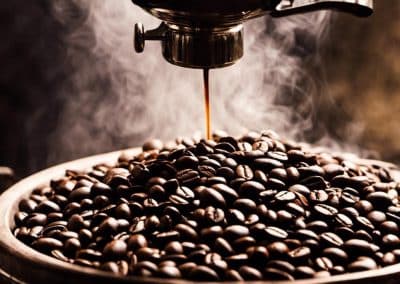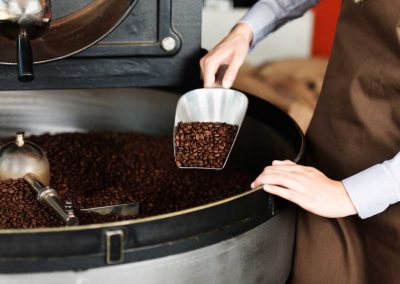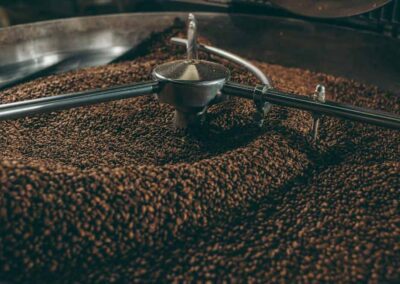Coffee roasting is a complex process. It transforms the green coffee seeds into the dark brown beans that we are familiar with. Then they are ready for grinding and brewing. It’s an art that involves heating the coffee beans over a specific amount of time and closely monitoring various variables. For example: temperature, drum speed, bean temperature, and moisture loss. This roasting process is what helps to bring out the aromatic compounds in coffee beans. Giving coffee its unique and rich flavor.
Interestingly, the flavor profile of coffee is directly influenced by the roasting process. Factors like the temperature used during roasting and the timing of cracks (the popping sounds heard during roasting) play a significant role in the final product. For instance, a light roast coffee is roasted at a relatively lower temperature, which results in a brighter and more acidic flavor profile. On the other hand, a dark roast coffee is roasted at a higher temperature, which leads to a bolder and more bitter taste. Moreover, the roasting process also affects the aroma and body of the coffee, with lighter roasts being more aromatic and medium to dark roasts having a fuller body.
Different Coffee Roasting Techniques
In the world of coffee roasting, there are four main roast levels: light roast, medium roast, medium-dark roast, and dark roast. These levels differ based on the amount of time the beans are exposed to heat. Each roast level imparts a distinct flavor profile to the coffee. For example, a light roast coffee tends to have more pronounced acidity and brighter flavors, characteristic of the coffee’s origin, while a dark roast coffee is characterized by a smoky, bold taste, often with notes of chocolate or spice.
Home coffee roasting methods can be quite diverse, ranging from Fluid Bed and Drum roasting to the use of stovetop pans and popcorn poppers. For instance, Fluid Bed roasting involves using hot air to circulate the beans, which ensures an even roast. On the other hand, Drum roasting utilizes a rotating drum to evenly roast the coffee beans, giving them a richer, more complex flavor. Stovetop pans and popcorn poppers are also used as alternative methods for home coffee roasting. Despite being less precise, these methods can still yield a satisfactory result for those just starting on their home roasting journey.
Home Coffee Roasting Tips and Equipment
Home coffee roasting provides numerous benefits, including convenience, cost-effectiveness, and the opportunity to customize flavor profiles according to personal preference. There are different types of home coffee roasting equipment available, each offering different advantages and capabilities. These include Fluid Bed and Drum roasters, stovetop pans, and popcorn poppers. Some popular models of home coffee roasters include the Fresh Roast SR540 and the Gene Café, both known for their performance and reliability.
When roasting coffee at home, there are several important factors to consider:
- Type of coffee beans: Different beans have different flavor profiles and roasting requirements. Choose a bean that suits your taste preference.
- Desired roast level: Light, medium, or dark? Your desired roast level will influence the roasting time and temperature.
- Roasting method: Whether you choose Fluid Bed or Drum roasting, or even a stovetop pan or popcorn popper, each method will offer a different experience and result.
Additionally, proper storage of both green and roasted beans is crucial to maintain freshness. Green coffee beans can last up to a year when stored properly in a cool, dry place. On the other hand, roasted beans should be allowed to rest or degas for at least overnight before long-term storage. They should be stored in a sealed container in a cool, dry, dark place.
Coffee Roasting Profiles and Levels
There are different types of coffee beans, such as Arabica and Robusta, each with different flavor profiles and roast levels. Arabica beans, for instance, are known for their sweeter taste and higher acidity. Robusta beans have a more bitter taste and a higher caffeine concentration, making them popular for espresso blends. The roasting process itself consists of three main stages: the drying stage, the browning stage, and the development stage. Each stage contributes differently to the flavor profile of the coffee.
The flavor profile of coffee can be influenced by a myriad of factors. These include the roast degree, roast time, and the time spent in each roasting stage. Light roasted coffees are more acidic and preserve more of the coffee’s original flavors. Dark roasted coffees are more bitter and exhibit more caramelization. The roast time and the time of each stage also affect the flavor profile. For example, fast roasting enhances all the flavors of the coffee, while slow roasting reduces acidity. Different roaster designs can affect the thermodynamics of roasting and create different flavors in the coffee.
Roasting Temperature and Time
The temperature, drum speed, bean temperature, and moisture loss during the roasting process are all critical factors that need to be carefully monitored and controlled. For instance, a higher roasting temperature can lead to a darker roast, while a slower drum speed can ensure a more even roast. Different roasting times can lead to different flavors in the coffee, with fast roasting enhancing all the flavors and slow roasting reducing acidity. As such, different roaster designs can also affect the thermodynamics of roasting and create different flavors in the coffee.
Filter and espresso coffee have different extraction methods and may require different roast profiles. For example, espresso roasts are usually darker and more robust to stand up to the high-pressure extraction process. Understanding the temperature and timing aspects of the roasting process is crucial for achieving the desired flavor profile. Experimenting with different temperature and timing combinations can help roasters develop their own unique roast profiles. This will create coffee with the perfect balance of flavors.
Common Mistakes to Avoid
Proper storage of green and roasted beans is crucial to maintain freshness. Green coffee beans can last up to a year when stored properly in a cool, dry place. On the other hand, roasted coffee beans should be allowed to rest or degas for at least overnight before long-term storage. They should be stored in a sealed container in a cool, dry, dark place. It is not necessary to wash green coffee beans before roasting, as this can lead to a less desirable roast. Instead, simply remove any visible debris before roasting.
Other common mistakes to avoid are:
- Over-roasting or under-roasting the beans: This could lead to a burnt taste or incomplete development of flavors.
- Not paying attention to the cracking sounds during the roasting process: The cracks are important indicators of the roast level.
- Not properly cooling down the roasted beans. Rapid cooling helps to stop the roasting process and lock in the desired flavor.
By avoiding these mistakes and following proper roasting techniques, coffee enthusiasts can achieve the perfect roast.
Conclusion
Understanding the basic concepts of the process and experimenting with different techniques is key to achieving the perfect roast. Whether it’s roasting coffee at home or exploring different coffee shops, learning about the roasting profiles and levels can significantly enhance one’s appreciation for the craft. This appreciation can deepen the enjoyment of every sip, making the coffee experience not just about the caffeine kick, but also about the journey of the beans from the farm to the cup.
For those who wish to delve deeper into the world of coffee roasting, consider taking a course or visiting local roasters. These experiences can provide further education and insight into the art and science of coffee roasting. They can also provide opportunities to sample different beans and roast levels, and even to develop your own unique roast profiles. With knowledge, practice, and passion, you can create coffee that perfectly suits your taste preferences, making each cup a personal masterpiece.









